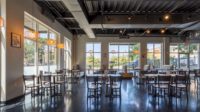The light load-bearing capacity of a 19th-century timber roof dictated an innovative HVAC retrofit for a historic downtown building renovation that's now home to the Detroit Institute of Music Education, a state-of-the-art music academy.
The six-story building, owned and managed by Detroit's Bedrock Real Estate Services, was designed of brick and timber in 1897, long before cooling towers, chillers, and other heavy rooftop HVAC systems were a reality. Conventional HVAC methods — like packaged rooftops, water source heat pumps with an evaporative closed-circuit cooler, or a four-pipe fan coil system with a rooftop chiller — all exceeded the roof's weight-bearing capacity. So engineers chose lighter-weight, variable refrigerant flow (VRF) technology, and rooftop equipment mounts with footings, to distribute weight strategically. The pads' anti-vibration attributes are critical in minimizing vibration and noise transmission to the music rehearsal and performance spaces and the third-floor recording studio. The anti-vibration feet allowed the engineering team to eliminate the expense of conventional spring isolators and other equipment, saving 30% in installation labor and materials.
Both technologies also minimized roof penetrations from ductwork, curbs, and fabricated I-beam supports, saving tens of thousands of dollars over traditional HVAC methods. Besides enhancing a quiet environment for music education, performance, and recording by up-and-coming artists, the HVAC system promises to preserve the roof's structural integrity.










